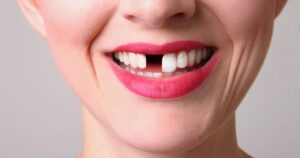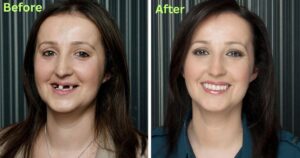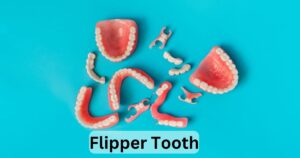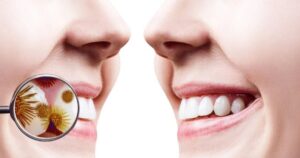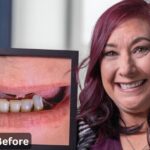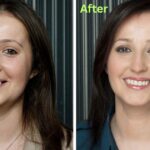Partial dentures are custom-made dental prosthetics that replace missing teeth, offering a solution for gaps in your smile. The number of teeth needed for a partial denture varies based on your unique dental situation.
Imagine unlocking the secret to a dazzling smile, even when a few pieces of the puzzle have gone missing. How Many Teeth Do You Need for a Partial Denture? This intriguing question holds the key to a journey of dental artistry and science where smiles are pieced back together with precision.
Are you ready to uncover the secret to a complete, confident smile? Stay with us as we delve deeper into the art and science of partial dentures. Whether you have questions, need guidance, or simply want to explore this fascinating topic further, we’re here to help you on your journey to a radiant, restored grin. Let’s continue this exciting exploration together.
What Are Partial Dentures?
Partial dentures are custom-made dental appliances designed to replace missing teeth in your mouth. They’re like puzzle pieces, expertly crafted to fit snugly, blending seamlessly with your existing teeth.
These dental marvels are designed to be removable for easy cleaning and maintenance. They consist of replacement teeth attached to a framework made from materials like metal or acrylic.
| Topic | Information |
| What Are Partial Dentures? | Custom-made dental appliances that replace missing teeth are available in removable and fixed types. |
| Types of Partial Dentures | Removable Partial Denture (custom-made, removable, cost-effective) |
| Fixed Partial Denture (non-removable, attached to healthy teeth or implants) | |
| Why Do You Need Partial Dentures? | To regain the ability to chew and eat comfortably, restore appearance, and improve speech. |
| Can You Sleep With Partial Dentures? | Typically not recommended; remove before sleeping for oral health and comfort. |
| Do Dentures Change Your Face? | Yes, they can support lips and cheeks, providing a more youthful and natural appearance. |
| Advantages of Partial Removable Dentures | Cost-effective, removable for cleaning, improved oral hygiene, natural look |
| Parts of Partial Removable Dentures | Base, Replacement Teeth, Clasps or Connectors, and Supporting Framework |
| Oral Hygiene Issues | Neglecting oral hygiene can lead to dental problems like cavities and gum disease. |
| Bone Resorption | A natural process that can be a concern in cases of tooth loss or osteoporosis |
Types of Partial Dentures
Partial dentures come in various types, each tailored to address different dental needs. The most common type is the “removable partial denture,” which can be taken in and out of your mouth as needed.
They use clasps or attachments to secure your remaining teeth, offering both function and aesthetics. Another option is the fixed partial denture, also known as a dental bridge. This type is permanently cemented in place, providing excellent stability and mimicking the appearance of natural teeth. Use instead of denture glue, these solutions offer a more reliable and long-lasting way to support your dental prosthesis.
Removable Partial Denture
A removable partial denture is a custom-made dental appliance used to replace missing teeth. It’s designed to fit comfortably in your mouth and can be easily taken out for cleaning and sleeping. This dental solution restores your smile, enhances your ability to eat and speak, and improves your overall oral health.
Removable partial dentures are a flexible option for people with a few missing teeth, as they’re both functional and cost-effective. They consist of replacement teeth attached to a gum-collared base, often made of acrylic or metal.
Fixed Partial Denture
A fixed partial denture, often called a dental bridge, is a tooth replacement option. It’s a non-removable appliance that bridges the gap left by missing teeth, restoring both function and aesthetics. This type of denture is attached to adjacent healthy teeth or dental implants, creating a sturdy and permanent solution for a seamless smile.
With a fixed partial denture, you can eat, speak, and smile confidently. The artificial teeth are custom-made to match your natural teeth, ensuring a harmonious and appealing appearance.
Why Do You Need Partial Dentures?
Partial dentures are necessary when you have missing teeth, and there are important reasons behind this need. First and foremost, they help you regain the ability to chew and eat comfortably. This is crucial for maintaining proper nutrition and overall health.
Partial dentures play a vital role in restoring your smile’s appearance and your self-confidence. Missing teeth can affect your speech and pronunciation, and partial dentures can help improve these aspects.
Can You Sleep With Partial Dentures?
Partial dentures, just like their full counterparts, are typically not recommended for sleeping. It’s essential to remove them before bedtime to give your gums and remaining teeth a chance to relax and recover from the day’s wear and tear.
Sleeping without your partial dentures helps prevent potential complications, maintains oral health, and ensures a comfortable night’s rest. So, the best practice is to take them out before you hit the hay and enjoy a peaceful night’s sleep.
Do Dentures Change Your Face?

Dentures can indeed change the way your face looks. When you lose teeth, it can lead to changes in your facial structure. Dentures are designed to replace missing teeth and support your lips and cheeks, helping restore a more youthful and natural appearance.
So, yes, dentures can have a positive impact on your face, often making it look fuller and more youthful, helping you regain your confidence and smile with pride.
Advantages of Partial Removable Dentures
Partial removable dentures offer numerous advantages for those with missing teeth. They are cost-effective, making dental care more accessible. These dentures are also removable, allowing for easier cleaning and maintenance, and contributing to improved oral hygiene.
Partial removable dentures are custom-made to fit your mouth comfortably, ensuring they blend seamlessly with your natural teeth for a natural look. They can enhance your ability to chew and speak, making daily activities more manageable.
Parts of Partial Removable Dentures
Partial removable dentures, or simply “partial dentures,” are marvels of modern dentistry. They consist of several essential components that work together to restore your smile’s functionality and aesthetics.
The base of a partial denture is custom-made to fit comfortably on your gums. It serves as a foundation to which the other components are attached, providing stability and support.
Replacement Teeth
These are the stars of the show, the prosthetic teeth that replace your missing ones. They are expertly crafted to match your natural teeth in color, shape, and size, making them blend seamlessly with your existing smile.
Clasps or Connectors
Clasps or connectors are designed to hook onto your natural teeth, anchoring the partial denture securely in place. They play a pivotal role in ensuring that your partial denture stays firmly positioned.
Supporting Framework
Some partial dentures include a supporting framework that rests on your palate for added stability. With these parts working harmoniously, partial removable dentures become a comfortable and aesthetically pleasing solution for those with missing teeth.
Keep Partials Clean and Your Natural Teeth Healthy
Keeping your partial dentures clean is essential for maintaining a healthy and comfortable smile. Regular cleaning helps prevent plaque buildup, which can lead to gum disease and other dental issues.
Neglecting your partials can cause problems, so make cleaning them a part of your daily routine. Brush and rinse them thoroughly, and visit your dentist regularly for check ups. Do You Need For A Partial Denture By keeping your partials clean, you’re not only preserving your artificial teeth but also ensuring your natural teeth stay strong and healthy.
Is There Any Disadvantage of Partial Dentures?
Partial dentures offer a range of benefits, but it’s essential to consider potential disadvantages too. One drawback is that they may feel a bit bulky or uncomfortable initially, and eating and speaking can take some getting used to.
Another potential disadvantage is that partial dentures can sometimes shift or become loose, leading to discomfort or embarrassment. Proper care and regular dental check-ups are crucial to avoiding these issues.
Oral Hygiene Issues
Oral hygiene is all about taking good care of your mouth, teeth, and gums. It’s not just about having a bright smile; it’s about keeping your overall health in check. When we neglect our oral hygiene, it can lead to a host of problems, from cavities to gum disease.
Bone Resorption
Bone resorption is a natural process where our bones break down and reabsorb their own tissue. This essential function helps regulate calcium levels in the body and shape our bones as we grow. However, in certain situations, such as tooth loss or osteoporosis, bone resorption can become a concern.
Bone resorption can result in weakened bones, fractures, and dental problems. To prevent excessive bone loss, it’s important to maintain a healthy diet rich in calcium and vitamin D, exercise regularly, and seek treatment for conditions like osteoporosis.
FAQ’S
Can you have a partial denture with no back teeth?
Yes, you can get partial dentures regardless of how many back teeth are missing. You would require one partial for each arch, but as long as some teeth remain for support, a partial would be a great solution!
Which is better dental bridge or denture?
If you are missing many teeth in a series or all of your teeth, it would be impractical to get implants for each of them.
How painful are partial dentures?
Partial dentures take some time to get used to, and you might find the first few days or weeks are an adjustment period in which you can experience a little discomfort and a fair amount of change.
Conclusion
Partial dentures are not just about numbers – they’re about restoring your natural smile and confidence. Whether you’re missing one tooth or several, these customized marvels blend seamlessly with your remaining teeth, creating a complete look. The magic number of teeth needed varies from person to person, based on your oral health and the guidance of your dentist.
This process blends art and science, involving assessment, impressions, custom design, fitting, and regular check-ups. The result? A smile that feels comfortable and looks natural. So, if you’re wondering how many teeth you need for a partial denture, remember that your dentist is your partner in this journey to regain a radiant, fully restored grin.

